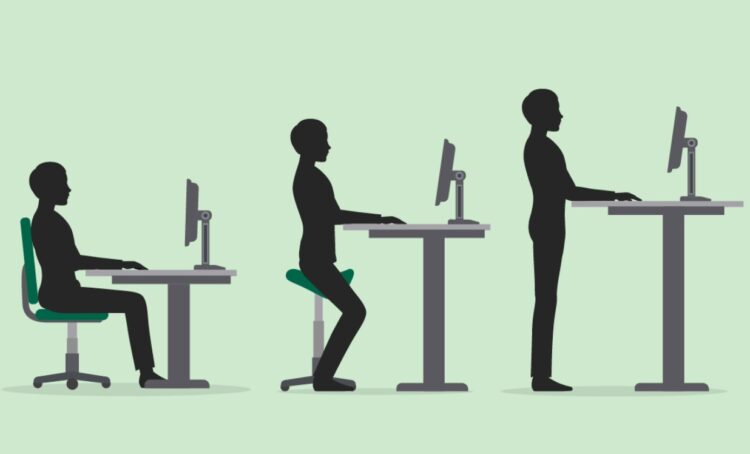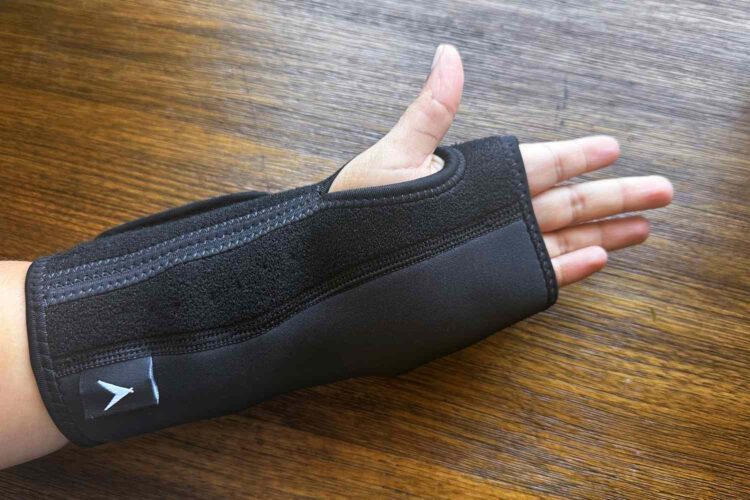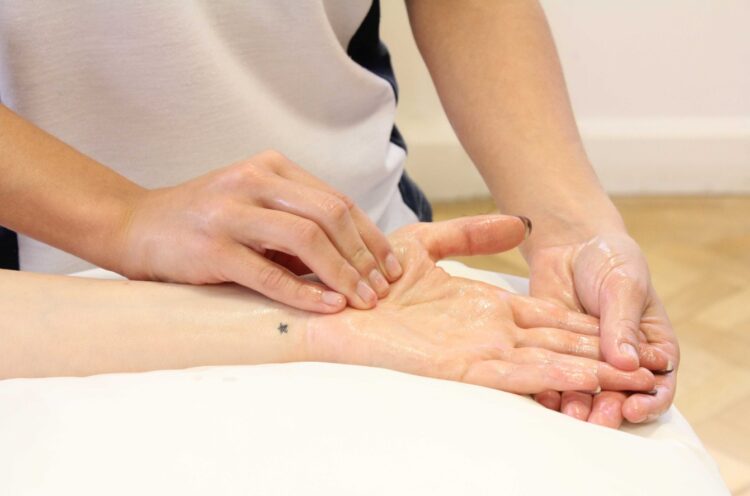Carpal Tunnel Syndrome (CTS) is a common condition that causes pain, numbness, and tingling in the hand and arm. It occurs when the median nerve, which runs from the forearm into the palm of the hand, becomes pressed or squeezed at the wrist.
With repetitive flexing and extending of the wrist, especially in awkward positions, the tunnel can become inflamed, causing the median nerve to be compressed. This results in the symptoms we associate with CTS.
The importance of finding relief for sufferers cannot be overstated. The discomfort and pain can be debilitating, affecting daily activities and quality of life. It can also impact one’s ability to work, especially for those whose jobs involve repetitive hand and wrist movements.
Therefore, it’s crucial to explore various ways to alleviate the symptoms and improve hand function.
Page Contents
1. Ergonomics and Workspace Optimization

Source: posturite.co.uk
Ergonomics is the science of designing and arranging things people use so that the people and things interact most efficiently and safely. In the context of CTS, ergonomic furniture and equipment can help reduce the strain on your wrist and hand, thereby alleviating symptoms.
Setting up an ergonomic workspace involves adjusting your chair, desk, and computer to fit your body’s proportions. Your chair should be at a height where your feet are flat on the floor, and your knees are at a 90-degree angle.
Your desk should be at a height where your elbows are also at a 90-degree angle when typing. Your computer monitor should be at eye level so you’re not bending your neck to see the screen.
2. Stretching and Strengthening Exercises
Regular wrist and hand exercises can help reduce the symptoms of CTS by improving flexibility and strength. They can also help prevent further injury.
Stretching routines for CTS typically involve extending and flexing the wrist and fingers. For example, you can extend your arm in front of you with your palm up. Then, use your other hand to gently pull your fingers down and back toward your body, stretching the forearm and wrist. Hold this position for 15-30 seconds and repeat a few times.
Strengthening exercises often involve resistance, such as squeezing a stress ball or using a rubber band around the fingers and opening the hand against the resistance. These exercises can help strengthen the muscles in the hand and wrist, providing more support and reducing strain on the median nerve.
3. Rest and Breaks
Rest is an essential part of recovery from any health condition, and Carpal Tunnel Syndrome is no exception. Continuous use of the affected hand and wrist can exacerbate symptoms, making it crucial to incorporate rest periods into your daily routine.
Taking regular breaks from repetitive activities can help reduce the strain on your wrist and hand. For instance, if your job involves a lot of typing, make sure to take a 5-minute break every hour. During this time, you can shake out your hands, stretch your fingers, and rest your wrists.
4. Carpal Tunnel Gloves

Source: health.com
Carpal tunnel gloves, also known as compression gloves, can provide significant relief for individuals suffering from Carpal Tunnel Syndrome. These specially designed gloves apply consistent, gentle pressure on the hands and wrists, helping to reduce inflammation and alleviate pain.
They also keep the wrists in a neutral position, which can prevent further strain on the median nerve. Many people find these gloves particularly beneficial for nighttime use, as they prevent the wrist from bending while sleeping. Always ensure to choose a pair that fits well and is comfortable to wear for extended periods.
5. Wrist Splints and Braces
Wrist splints, also known as wrist braces, can play a significant role in reducing the symptoms of Carpal Tunnel Syndrome. They work by keeping the wrist in a neutral position, which minimizes pressure on the median nerve.
There are various types of wrist braces available, including night splints designed to prevent your wrist from bending while you sleep, and day braces that allow more movement for daily activities. Some braces are adjustable, allowing you to control the amount of support and compression.
6. Pain Management Techniques
Managing pain is a crucial aspect of dealing with Carpal Tunnel Syndrome. Over-the-counter medications, such as nonsteroidal anti-inflammatory drugs (NSAIDs), can help reduce pain and inflammation.
Alternative pain management methods, such as heat and cold therapy, can also provide relief. Applying a cold pack can help reduce inflammation, while heat can help increase blood flow and relax the muscles.
7. Trigger Point Therapy

Source: physio.co.uk
Trigger point therapy is a type of therapeutic massage that focuses on detecting and releasing trigger points. These are specific “knots” that form in muscles and can cause pain throughout the body. For Carpal Tunnel Syndrome, trigger points often develop in the muscles of the forearm and hand.
Self-trigger point therapy involves applying pressure to these knots to help release them. This can be done using your fingers, a massage ball, or a specialized trigger point tool. However, it’s important to learn the correct techniques to avoid causing further harm.
8. Nerve Gliding Exercises
Nerve gliding exercises, also known as nerve flossing or neural mobilization, can help with Carpal Tunnel Syndrome. These exercises aim to improve the movement of nerves, which can become restricted due to inflammation or compression.
Nerve gliding exercises for CTS involve specific movements of the hand, wrist, and fingers that “glide” the median nerve within the carpal tunnel. This can help reduce nerve tension, improve nerve function, and alleviate symptoms.
9. Acupuncture and Acupressure
Acupuncture and acupressure are alternative therapies that can provide relief from Carpal Tunnel Syndrome. Both involve stimulating specific points on the body to promote healing and pain relief.
Acupuncture involves inserting thin needles into these points, while acupressure involves applying pressure using the hands or specialized tools. Both methods can help reduce inflammation, improve blood flow, and alleviate pain associated with CTS.
10. Lifestyle Modifications

Source: carespace.health
Lifestyle modifications can play a significant role in managing Carpal Tunnel Syndrome. Dietary changes, for instance, can help reduce inflammation. Consuming a diet rich in anti-inflammatory foods like fruits, vegetables, lean proteins, and healthy fats can be beneficial.
Maintaining a healthy weight is also important. Excess weight can increase pressure on the carpal tunnel, exacerbating symptoms. Regular physical activity, combined with a balanced diet, can help manage weight effectively.
Workstation and Device Adaptations
Modifying your workstation can significantly improve comfort and reduce strain on your wrist and hand. This might involve using an ergonomic keyboard and mouse, adjusting the height of your chair and desk, or using a wrist rest.
Specialized devices are also available for individuals with Carpal Tunnel Syndrome. These include ergonomic keyboards designed to keep the wrists in a neutral position, vertical mice that reduce wrist twisting, and speech-to-text software that can minimize typing.
Stress Management
Stress and anxiety can exacerbate Carpal Tunnel Syndrome. This is because stress can cause muscle tension and inflammation, which can increase pressure on the median nerve.
Techniques for managing stress and anxiety include deep breathing exercises, progressive muscle relaxation, and mindfulness meditation. Regular physical activity and a healthy diet can also help manage stress levels.
Yoga and Meditation
Yoga and meditation can be particularly beneficial for managing Carpal Tunnel Syndrome. Yoga poses that stretch and strengthen the wrists can help alleviate symptoms, while meditation can help reduce stress and promote overall well-being.
When to Seek Medical Advice

Source: pexels.com
While the strategies outlined above can help manage Carpal Tunnel Syndrome, it’s important to seek medical advice if your symptoms are severe, worsening, or impacting your quality of life. Early diagnosis and treatment can prevent permanent nerve damage and improve your prognosis.
Consulting a healthcare professional can provide you with personalized advice and treatment options. This might involve physical therapy, medication, or in severe cases, surgery.





